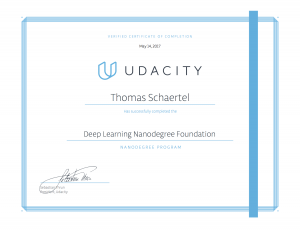Recently I graduated successfully Udacity’s Deep Learning (DL) Nanodegree after four month of full-time studying the curriculum. The math and programming of five projects were very demanding. We used mainly Python and Google’s Tensorflow to build the models and train the networks. While I did not have local access to sophisticated GPU hardware on my computer, I used Amazon’s AWS or FloydHub, which offer both GPU time to train my neural networks on NVIDIA graphics processor units (GPU). Our mission was to complete five projects, which were judged by Udacity mentors:
- Build a simple network to make predictions of bike sharing usage (neural network)
- Build a neural network that classifies objects from images (convolutional neural network).
- Use deep learning to generate new scripts (recurrent neural network, LSTM)
- Build a chatbot that translates text in real time (sequence to sequence, embeddings, encoder, decoder)
- Use a generative adversarial network (GAN) to generate novel faces.

It was amazing, what can be done nowadays by machine learning/deep learning. A couple of years ago I graduated the artificial intelligence (AI) class by edX | BerkeleyX with Pieter Abbeel and Dan Klein. It’s really amazing what can be done with DL now compared to the exact understanding of search by A* or alpha-beta pruning to mention a few techniques from AI. It’s unbelievable what can be done now, without programming the computer specifically to the domain with fixed code, instead rely on learning the features by himself.
But as always, this is just the start of a journey: There is more into those subjects now, be it Self-Driving Cars, Robotics, or another brush up in Artificial Intelligence or Machine Learning. I’ll keep you informed about my endeavours. But it also looks like I need to invest in local GPU hardware to speed things up!
